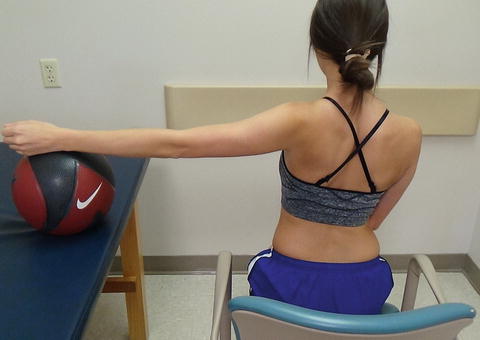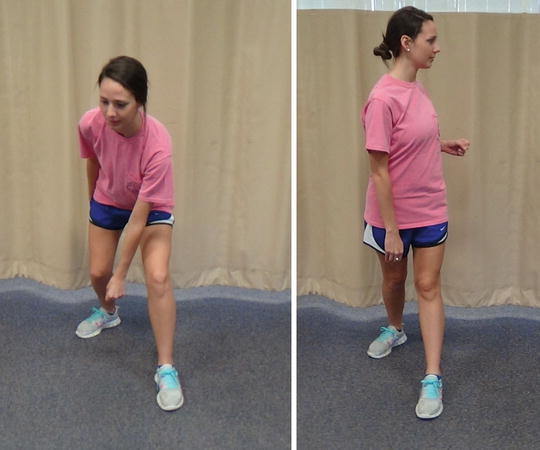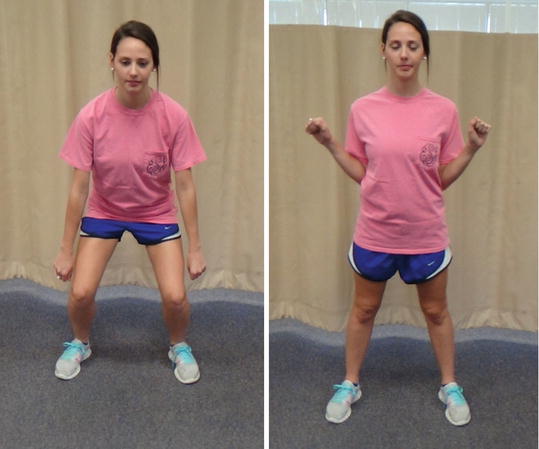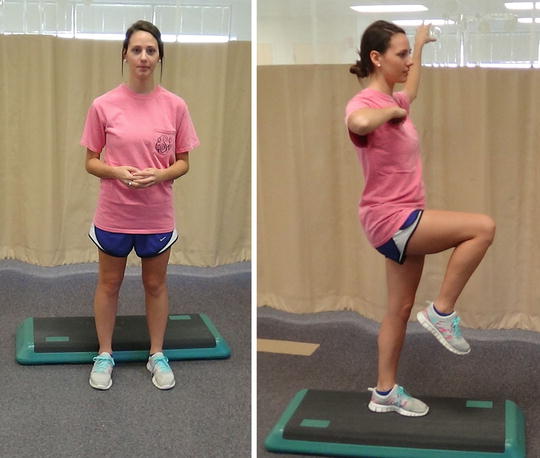Fig. 25.1
Low row exercise for serratus anterior and lower trapezius strengthening

Fig. 25.2
Inferior glide exercise utilizing co-contraction of shoulder stabilizers

Fig. 25.3
Lawnmower maneuver utilizes multiple kinetic chain segments to improve scapular stability

Fig. 25.4
The robbery maneuver helps regain adequate scapular retraction and depression by instructing the patient to “place the elbows in the back pockets”
The utilization of closed kinetic chain maneuvers can be implemented as a means of providing feedback and less loading through the affected extremity. Typically, when tissue is compromised, inflamed, or irritated, closed-chain exercises are implemented early in the rehabilitation process due to the decreased amount of shear force and stress they confer to the involved joints. These types of exercises are best suited for reestablishing the proximal stability and control in the links of the kinetic chain such as the scapula and pelvis. Open-chain exercises , which generate greater joint loads in comparison to closed-chain activities, should be utilized later in rehabilitation programs due to the increased joint reactive forces resulting from the longer arm levers inherent in these exercises.
Another rationale behind the initial closed-chain emphasis is that the shoulder functions as a true closed chain to transfer forces [30, 31], and in such training it is the optimal method to restore activation in inhibited and weak muscles. Specific training of inhibited muscles is accomplished by placing the extremity in a closed-chain position, emphasizing normal activation patterns, and focusing on the muscle of interest by deemphasizing compensatory muscle activation. For example, if a patient presents with shrugging during arm elevation, it can be assumed that the lower trapezius and/or serratus anterior are not working effectively dynamically. A closed-chain exercise such as the low row should be utilized because this “short lever” positioning would selectively emphasize those muscles which would decrease the upper trapezius’ ability to activate. Once the normal activation pattern of the inhibited muscles has been restored, more challenging exercises which promote larger ranges of motion and multiple planes can be employed.
The preceding areas of the kinetic chain approach focused on alleviating underlying impairments/deficits, creating a sound foundation of muscle activation, and introducing strength through safe lower load maneuvers. The final key aspect of the kinetic chain approach for rehabilitation is the incorporation of multi-planar exercises which will utilize the gains made in the preceding areas in order to prepare patients to perform more complex tasks. The lower extremity and core should be challenged to perform in its natural capacity as a base of support and generator of power during recreational and labor-intensive tasks, while the focus for the upper extremity should be to serve as a funnel for the energy generated from the preceding anatomical segments. Since upper extremity tasks utilize rotary motion from the core and shoulders throughout the entire sequence of throwing and swinging, this strategy is logically employed as it is more functional. For example, to properly mimic and thereby enhance the throwing motion, a two-phase exercise known as the power position step back (Fig. 25.5), which encourages single-leg and trunk stability along with scapular retraction and arm placement, can be prescribed. Each phase of the maneuver should be introduced individually then progressed to more functional stages where the actions are performed sequentially.


Fig. 25.5
Power position step back. This exercise helps retrain the motor system to simultaneously perform stability and complex, challenging motion at multiple kinetic chain segments
Proper safe progression is the primary concern in rehabilitation. In the kinetic chain rehabilitation process, multiple segments are active. Each exercise movement must be of quality in nature and integrate safe and appropriate movement patterns. The movement patterns prescribed progress from proximal-to-distal segments of the kinetic chain. As loading occurs in the distal segments, the exercise choices also progress from a static exercise to a dynamic choice of movements. In order to attain successful movement patterns, the patients must be provided feedback both verbal and tactile to avoid compensatory movements that hinder the kinetic chain. The feedback enables the person to identify the errors and correct the movements and commit the patterns to muscle memory. Slow removal of feedback can occur as the patient progresses to a more independent awareness of segmental function. Additional progression includes various resistance tools, change in movement patterns, and variable surfaces. As a precaution, the clinician overseeing the rehabilitation protocol must monitor the patient closely in order to prevent harmful overload. In preventing kinetic chain rehabilitation pitfalls, the clinician must also monitor some of the most common areas of weakness which transfer to compensatory movements. For example, scapulothoracic rhythm monitoring is essential as it is a primary indicator of compensation. Fatigue is a common concern that hinders the kinetic chain rehabilitation process. Thus, the goal of each exercise is performed without compensatory movement patterns.
Functional Readiness
The final consideration in postoperative shoulder rehabilitation is to determine the patient’s ability to return to desired activities. Using dynamic performance measurements beyond traditional impairment testing may help reduce or eliminate premature return to activity (i.e., return prior to the optimization of functional capability necessary to perform sport-specific or work-specific tasks) [32]. This is especially challenging for clinicians because no universal method of functional assessment for the shoulder has been accepted or adopted for clinical practice. This is likely due to the numerous assessment maneuvers and test batteries that have been developed in order to assess shoulder function, most of which have been shown to have acceptable levels of inter-tester and/or intra-tester reliability [33–36]. Thus, the selection of the most appropriate method of testing is indeed difficult. Further complicating the matter, existing testing methods have been designed to assess only one component of physical function (strength, flexibility, power, etc.) or have been designed for specific populations only [32].
With the absence of a universal performance measures, some experts have suggested that interval programs, specific to individual sports or vocations, may be useful for assessing skills and for qualitatively assessing performance under controlled conditions [37–39]. Interval programs can be described as sports-specific return to play progressions designed to mimic the basic maneuvers and demands of a specific sport [37]. The programs are often implemented in the controlled, rehabilitation setting so the patient can be carefully monitored yet challenged without influence or pressure from external parties (coaches, teammates, etc.). Periodic testing throughout the rehabilitation process may give all involved parties insight as to whether patient expectations are being achieved, biomechanical improvements are being made, and if set goals are possibly being reached. The shortcomings of interval programs are their inherent subjectivity and that they serve as progressive supplements to rehabilitation, rather than as testing regimens. The lack of a grading scale or scoring metric within the interval program construct does not assist clinicians in making return to activity determinations. In order to overcome the individual limitations of dynamic performance testing and interval programs, a comprehensive approach is recommended which integrates multiple components including the use of patient self-reported function, impairment measures (strength, range of motion, etc.), dynamic performance testing, and interval programs as well as biomechanical assessments [32]. This ideal comprehensive approach utilizes information from various sources and allows kinetic chain-based factors to be considered and accounted for, aiding clinicians in identifying adequacies and/or deficiencies within the system [32, 40].
To optimize determination of function, clinicians should first select a dynamic performance measure that is both closely related to the activity the patient is attempting to return to and assists in measuring patient-specific goals established prior to the beginning of rehabilitation. Next, a biomechanical assessment should be conducted to determine if the patient can adequately perform the task in question and to assess the quality of the motion. Mechanical nodes have been described where recommended motions have been advocated for optimal performance and injury reduction during athletic tasks [4, 41]. “Nodes” are specific segment positions and motions that are determined to be fundamental for efficient linkage and sequencing of multiple segments in a kinetic chain [5]. An example of a sequential series of nodes would be the achievement of adequate knee flexion when initiating the cocking motion of the serve in tennis which is then followed by hip and trunk counterrotation and scapular retraction and concludes with propulsion of the body up and through the ball and long axis rotation of the arm following ball contact [5, 41]. The posttreatment mechanical examination is important in identifying anatomical and/or mechanical abnormalities as well as a lack of node achievement because the motor system has not been regularly exposed to the specific tasks required to perform the sport or job due to the constraints of the rehabilitation process. Additionally, improvements in strength and/or flexibility may lead to altered performance initially because the athlete is not familiar with how to best utilize the new gains. Clinicians should allot an adequate time to retrain the motor system in order to perform under the additional or constrained degrees of freedom. Finally, in order to routinely utilize the proper mechanics and to restore muscular endurance, clinicians should utilize the interval task program specific to individual patient needs. The programs should not be standardized but be developed and advanced based on individual patient improvement and physiological adaptation.
Stay updated, free articles. Join our Telegram channel

Full access? Get Clinical Tree








